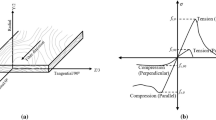Abstract
The behaviour of timber connections is very complex because of the interaction between brittle and ductile failure modes that develop within the contact areas between the timber and the dowel. Simulating this behaviour numerically requires the use of multidimensional failure criteria as well as the use of coupled constitutive equations accounting for both non-linear isotropic hardening and isotropic ductile damage. Such a formulation is proposed in the present work and implemented within a Vumat user-defined subroutine in Abaqus/Explicit. The model is used to simulate the behaviour of a double shear timber steel connection. Good agreement was found between the FE results and experimental ones, which showed the good capability of the model to predict the onset of ductile damage and growth. It was found that failure results from ductile defects initiation, growth and propagation inside narrow shear bands wherein the plastic strain is highly localised.











Similar content being viewed by others
References
Johansen K (1949) Theory of timber connections, vol 9. International association for bridge and structural engineering (IABSE) Publication, Bern, pp 249–262
Eurocode 5: design of timber structures—part 1–1: general—common rules and rules for buildings. Brussels (2010)
Quenneville P, Mohammad M (2000) On the failure modes and strength of steel wood-steel bolted timber connections loaded parallel-to-grain. Can J Civ Eng 27:761–773
Stahl DC, Wolfe RW, Begel M (2004) Improved analysis of timber rivet connections. J Struct Eng ASCE 130:1272–1279
Zarnani P, Quenneville P (2014) Strength of timber connections under potential failure modes: an improved design procedure. Constr Build Mater 60:81–90
Dorn M, De Borst K, Eberhardsteiner J (2013) Experiments on dowel-type timber connections. Eng Struct 47:67–80
Awaludin A, Hirai T, Hayashikawa T, Sasaki Y (2008) Load-carrying capacity of steel-to-timber joints with a pretensioned bolt. J Wood Sci 54(5):362–368
Sjödin J, Serrano E (2008) An experimental study of the effects of moisture variations and gradients in the joint area in steel-timber dowel joints. Holzforschung 62(2):243–247
Rammer DR, Winistorfer SG (2001) Effect of moisture content on dowel-bearing strength. Wood Fiber Sci 33(1):126–139
Jensen J (2005) Splitting strength of beams loaded perpendicular to grain by dowel joints. J Wood Sci 51(5):480–485
Xu BH, Taazount M, Bouchaïr A, Racher P (2009) Numerical 3D finite element modelling and experimental tests for dowel-type timber joints. Constr Build Mater 23:3043–3052
Xu BH, Bouchaïr A, Taazount M, Vega EJ (2009) Numerical and experimental analyses of multiple-dowel steel-to-timber joints in tension perpendicular to grain. Eng Struct 31:2357–2367
Resch E, Kaliske M (2010) Three-dimensional numerical analyses of load-bearing behavior and failure of multiple double-shear dowel-type connections in timber engineering. Comput Struct 88:165–177
Moses DM, Prion HGL (2003) A three-dimensional model for bolted connections in wood. Can J Civil Eng 30:555–567
Kharouf N, McClure G, Smith I (2003) Elasto-plastic modelling of wood bolted connections. Comput Struct 81:747–754
Patton-Mallory M, Cramer SM, Smith FW, Pellicane PJ (1997) Nonlinear material models for analysis of bolted wood connections. J Struct Eng 123:1063–1070
Reynolds T, Harris R, Chang W-S (2014) Stiffness of dowel-type timber connections under pre-yield oscillating loads. Eng Struct 65:21–29
Chui Y, Ni C (1997) Load-embedment response of timber to reversed cyclic load. Wood Fiber Sci 29(2):148–160
Pozza L, Scotta R, Vitaliani R (2009) A non linear numerical model for the assessment of the seismic behaviour and ductility factor of X-lam timber structures. In: Proceeding of international symposium on timber structures, Istanbul, 25–27 June 2009, pp 151–162
Yasumura M, Ito Y (2014) Racking resistance and ductility of CLT shear walls under horizontal and vertical loads. In: World conference on timber engineering WCTE, Quebec, 10–14 Aug 2014
Dolan JD (1994) Proposed test method for dynamic properties of connections assembled with mechanical fasteners. J Test Eval 22(6):542–547
Reiterer A, Stanzl-Tschegg Stefanie E (2001) Compressive behaviour of softwood under uniaxial loading at different orientations to the grain. Mech Mater 33:705–715
Oudjene M, Khelifa M (2009) Elasto-plastic constitutive law for wood behaviour under compressive loadings. Constr Build Mater 23(11):3359–3366
Khennane A, Khelifa M, Bleron L, Viguier J (2014) Numerical modelling of ductile damage evolution in tensile and bending tests of timber structures. Mech Mater 68:228–236
Khelifa M, Celzard A (2014) Numerical analysis of flexural strengthening of timber beams reinforced with CFRP strips. Compos Struct 111:393–400
Abaqus (2011) Theory manual. Version 6.11. Dassault Systèmes Simulia Corporation, Providence
Laplanche K (2006) Etude du comportement au feu des assemblages de structures bois: approche expérimentale et modélisation. PhD Thesis, Université Blaise Pascal
Author information
Authors and Affiliations
Corresponding author
Rights and permissions
About this article
Cite this article
Khelifa, M., Khennane, A., El Ganaoui, M. et al. Numerical damage prediction in dowel connections of wooden structures. Mater Struct 49, 1829–1840 (2016). https://doi.org/10.1617/s11527-015-0615-5
Received:
Accepted:
Published:
Issue Date:
DOI: https://doi.org/10.1617/s11527-015-0615-5




